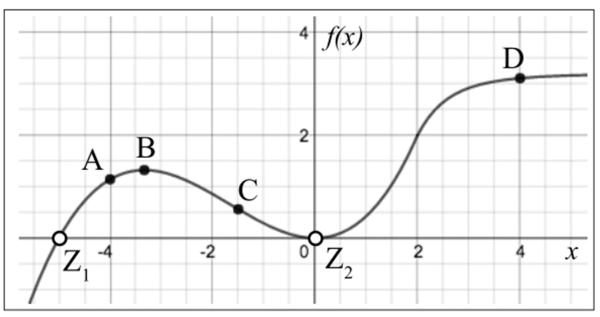Science:Math Exam Resources/Courses/MATH102/December 2015/Question 11
{{#incat:MER QGQ flag|{{#incat:MER QGH flag|{{#incat:MER QGS flag|}}}}}}
• Q1 • Q2 • Q3 • Q4 • Q5 • Q6 • Q7 • Q8 • Q9 • Q10 (a) • Q10 (b) • Q11 • Q12 • Q13 • Q14 (a) • Q14 (b) • Q15 • Q16 • Q17 • Q18 (a) • Q18 (b) • Q18 (c) • Q18 (d) • Q19 (a) • Q19 (b) • Q19 (c) • Q19 (d) • Q19 (e) •
Question 11 |
|---|
|
Consider each of the labeled points (solid dot) on the graph of as a starting point for Newton’s method. To which zero of the function (empty dots , , or neither) will Newton’s method converge for each one? You may assume that the graph of the function continues off the edges of the graph with no significant change in direction. |
|
Make sure you understand the problem fully: What is the question asking you to do? Are there specific conditions or constraints that you should take note of? How will you know if your answer is correct from your work only? Can you rephrase the question in your own words in a way that makes sense to you? |
|
If you are stuck, check the hints below. Read the first one and consider it for a while. Does it give you a new idea on how to approach the problem? If so, try it! If after a while you are still stuck, go for the next hint. |
Hint 1 |
|---|
|
Remember Newton's method is a iteration:
|
Hint 2 |
|---|
|
Graphically, you can find the point by drawing the tangent line to the graph at and looking at the intersection with the x-axis. |
|
Checking a solution serves two purposes: helping you if, after having used all the hints, you still are stuck on the problem; or if you have solved the problem and would like to check your work.
|
Solution |
|---|
|
A: use the equation . After the first iteration, the next point will locate on the left side of , then a few times later, it will gradually converge to . B: the derivative at B is 0, thus Newton's method does not work in this case. C: after the first iteration, the next point will locate on the left side of , then a few times later, it will gradually converge to . D: after the first iteration, the next point will locate on the very far left side of (because the derivative is small at D), then if assume that the graph of the function continues off the edges of the graph with no significant change in direction, the point will approach on the left side gradually with the iteration. answer: |
{{#incat:MER CT flag||
}}








